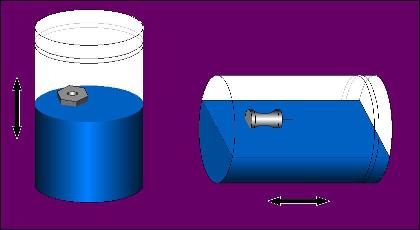
Large grains are well known to rise to the top of vibrated granular beds. There is, however, a shaking regime in which large, heavy grains rise, but equally large, light grains sink in a vibrated granular bed. This behavior occurs in deep beds of fine powders subjected to high amplitude vibrations -- precisely the regime encountered during transportation of industrial powders. See Phys. Rev.Letter 81 (1998) 4365-8; also "The Brazil nut effect - in reverse," Nature 429 (2004) 352-3 .
A quicktime movie of this effect appears here. The large pink intruder in the movie has density lower than the surrounding bed; the large orange intruder has density higher than the bed.
The prototypical example of granular segregation, termed the "Brazil nut effect", can be easily recreated -- and challenged . In the figure below, we illustrate the effect: if a small spice jar partially filled with salt and containing a large heavy intruder (e.g. a steel hex nut) and an equally large but light intruder (e.g. a pushpin) is shaken vertically, the nut will rapidly rise to the surface, while the pin will sink. In contrast, if the jar is shaken horizontally, the pin will rise and the nut will sink.

A more simpleminded experiment could scarcely be devised, yet the paradoxical outcome reveals the complexity that one can find in the simplest of granular problems -- which can conspire to make more complex, industrial, granular systems appear to be utterly intractable. The cause of the buoyancy of large intruders such as the hex nut in vertically vibrated granular systems has been described by a number of competing models; the causes of the sinking of the pushpin and of the reversal of the intruders' fates in a horizontal bed remain subjects of ongoing research.